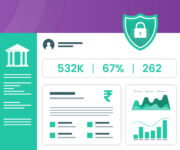In the era of information technology, data is the ‘new oil’. It is the essential commodity that drives businesses. The ability to gather, analyse, and use relevant data accurately makes or breaks an organisation in today’s age.
Consequently, data security in cyberspace is a critical concern for firms operating in the digital space.
Digital lending, in particular, is an activity vulnerable to the dangers and consequences of cyber attacks. Given the sensitive nature and importance of the information handled in the lending process, lenders are responsible and accountable for reams of valuable data that are soft targets for all sorts of cyber attacks.
This article will focus on why robust, unassailable, and resilient loan management systems (LMS) are needed to ensure the privacy and security of such data.
Significance of Data Security in Digital Lending
Centre for Financial Inclusion Accion, in a recent report based on its survey on the risks for the fintech lending sector in India, lists data privacy as the third most severe menace to the industry.
Most often, cyberattacks are financially motivated, so banks and non-banking financial institutions become the prime target of the perpetrators.
Devastating Results of Data Security Breaches
Data security breaches in loan management systems have far-reaching implications for lenders. Compromised digital security results in stolen or lost private information or corrupted data, jeopardising business decisions.
Online lenders have to bear monetary and nonmonetary prices for such cyber attacks. According to the IBM estimate, the average global cost of a data breach in 2022 is $4.35 million.
This often includes:
- penalties imposed by regulators.
- compensation to data owners who are the victims.
- legal and administrative costs associated with data recovery and lawsuits associated with the incident.
- costs of business disruption due to data losses.
The non-material damages might include:
- loss of customer trust.
- reputation damages.
- misuse of data by the offenders for criminal activities.
- negative impact on employee morale and productivity.
Common Data Security Issues for Loan Management Systems
Data security threats may originate internally or externally and can be intentional or unintentional. Data compromises within the company are referred to as data leaks, while those that occur due to external threats are called data breaches. Both issues generally happen due to vulnerabilities in the loan management systems.
Within the LMS, various levels are susceptible to potential cyber-attacks. For example:
- Front-end level, which is usually the digital lending apps/platforms
- Mid-level administrative functions like document analysis and verification, credit appraisals, risk assessment, AML checks, etc., and
- Back office functions like regulatory reporting, management information system (MIS), record management, reconciliation, etc.
There are numerous ways in which privileged information becomes exposed.
Internal reasons for compromised data security
- Human errors
Some examples of unintentional human error are weak passwords, password sharing, accidental disclosure of confidential information over emails, and falling for malicious tricks like phishing, spoofing, etc.
- Insider misappropriation
Data abuse by insiders is an even more serious offence in which employees gain access to company data, with or without authorisation, intending to share with or sell it to third parties.
- Risks arising from remote work
Remote working became a crucial business continuity plan for firms. One disadvantage of virtual offices in digital lending is that staff no longer access loan management systems via secure and dedicated networks and devices. Their logins are vulnerable to targeted hacking attempts.
- Antivirus software and loan management systems that are outdated
Malware programs are constantly changing along with digital lending technology. Legacy LMSs protected by obsolete antivirus software are no match for advanced computer viruses.
External challenges to data security
- Phishing
Phishing is the most prevalent data threat that digital banking customers encounter. The offenders make false communications while appearing as reliable organisations to obtain the victims’ private financial and personal information.
- Ransomware attacks
Ransomware is a malicious program that gets access to your systems, networks, and databases and blocks you from using them.
- Social Engineering
Like phishing, social engineering manipulates data owners and custodians to divulge confidential details.
- Distributed Denial of Service (DDoS)
The attackers create artificial traffic to the site, overwhelming the network and causing it to crash. This technique is used as a distraction mechanism, while the miscreants can use malware to access the database during downtime.
- Cloud-based risks
More and more digital businesses are switching to cloud-based platforms for cost and operational efficiency. This makes cloud-based infrastructure an attractive potential target for hackers.
Resolving Data Security Issues and Preventing Cyber Attacks in Loan Management System
Now that the data risks in loan management system and their probable causes are identified, the next step is to implement preventive measures.
There are several steps that lenders can take to ensure the security of their systems and databases in the digital lending environment, such as:
- Patch up potential weak spots in the software and bolster with firewalls and the latest anti-virus programs regularly updated.
- Regularly train the staff on security best practices and the firm’s data security policy.
- Have an elaborate Disaster Recovery(DR) plan in place for data security breaches. Conduct DR drills regularly to guarantee their effectiveness. The drills will also highlight the necessity for data security training.
- Implement strict access protocols such as multi-factor authentication.
- Most importantly, educate the customers about the data risks they might encounter, e.g., voice phishing or whaling.
Wrapping Up
When it comes to data security, it is always preferable to be proactive rather than reactive. The volume of data handled by loan management systems is increasing as the pace of digital lending quickens, so lenders must always be ready for the worst.
Upgrading data security must be an ongoing activity for LMS rather than a periodic function. Remember that as loan management improves, so do data breaching techniques.
This is where you will need Finezza to manage your lending portfolio. Our end-to-end lending management solutions are trusted by brands like ftcash, Hiranandani Financial Services, gromor Finance, and UC Inclusive Credit, to name a few.
Finezza’s comprehensive Loan Management System addresses your data security concerns with our secured data access control.
Book a demo to know more.




Leave a Reply